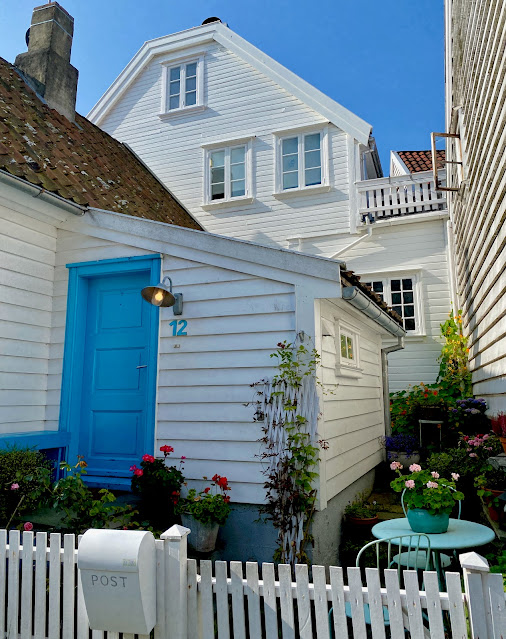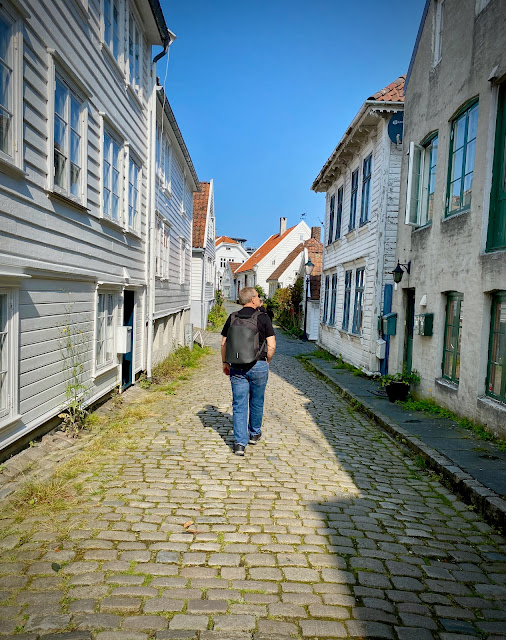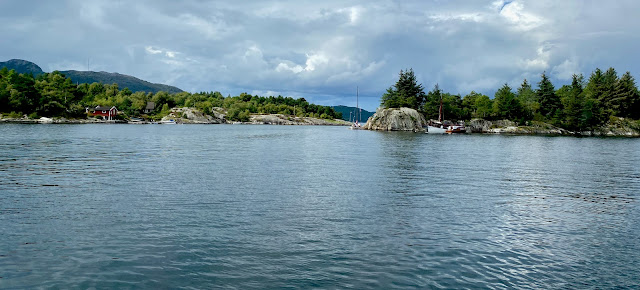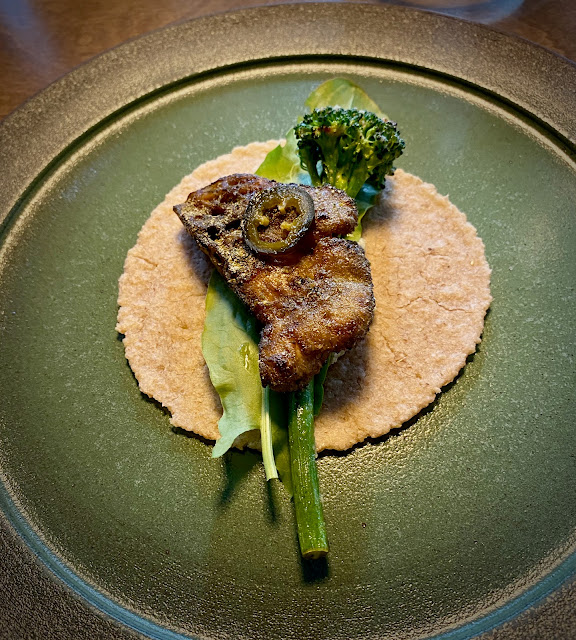 |
| The charming cobbles and white-painted houses of Stavanger's old town |
Hello again from a markedly more autumnal Britain, where two weeks ago I do believe we saw the last of the unseasonably hot weather (27ºC in the middle of September!).
Since we inherited our cat Daisy May over a year ago, our travels have been severely curtailed as she's too old to be boarded (she turns 18 in January), and because we live on school grounds we're not permitted to have commercial petsitters come and stay. Daisy was also recently diagnosed with hyperthyroidism, requiring her to have medication twice a day. All this means that most of the time Kevin and I now have to travel separately while the other stays behind to care for Daisy. However, in late August we did manage to rope in several neighbours to cover a four-day period, allowing us to spend a few nights in Stavanger.
Why Stavanger? you ask, and indeed some of you might not even know the name. Well, a Norwegian friend told me many years ago it was his favourite city in Norway and I knew Stavanger had a charming 'old town' section chock-full of 18th and 19th century timber houses, which I had long wished to see.
It's a small city by international standards, but is in fact Norway's fourth largest, with a population of about 130,000. It was officially founded in 1125, making it one of the country's oldest cities. These days it's acknowledged as the oil capital of Norway, having been designated the main hub for that industry in 1969 when the North Sea oil boom commenced, which led to rapid growth in the city's population. Stavanger frequently makes it onto the various lists of most expensive cities in the world, and it has even been ranked as the world's most expensive city by certain indices.
Although I've been to Bergen multiple times, I'd never been further south on Norway's south-west coast and with fairly cheap flights available, I decided that's where we'd go for our precious few days away together.
 |
| This resident in Stavanger's old town boldly went for a candy pink front door, whereas most others are white or blue |
 |
| Facing onto the harbour, I love the raw timber finish of this cottage's traditional front door - in Stavanger, Norway |
 |
| A peek into the tiny courtyard garden of one of the traditional timber cottages in Stavanger's old town |
 |
| You see this kind of 'window art' all over Norway. It serves the dual purpose of providing some privacy as well as being decorative - in Stavanger's old town |
 |
| I love how the door and house number are colour-coordinated 😃 - cottage in Stavanger's old town |
 |
| We enjoyed coffee al fresco at the historic Frk.Krag Kafé in Stavanger's old town |
Stavanger's old town is located alongside the working harbour, and that's very convenient for the thousands of tourists who are daily disgorged from massive cruise ships. It means they only have to walk literally one street back from the quayside to enjoy the quaint timber buildings and cobbled streets. Now, I understand many people enjoy cruising and it's a far less stressful way to travel from place to place. You don't have to unpack and repack and move to new accommodation. Whilst you are at sea and particularly if the weather's rubbish there are amazing activities and facilities on board. I have nothing against cruising in theory. However, in practice these GIGANTIC cruise vessels are very intrusive, especially in a small place like Stavanger.
Despite the income this generates for the town, I think there comes a point where you question whether that's the most important factor, particularly in an extremely wealthy country like Norway where they are not dependent on tourist income. There is a strong local voice of protest, with pamphlets posted around seeking support to stop the really big ships from docking there.
Please refer to the photos below which provide some perspective. There are families who have lived in Stavanger's old town for many generations, and most of the time they no longer have the outlook their forebears enjoyed because it's blocked by ships that are the equivalent of a ten-storey building. Each day we were in Stavanger there were at least two of these colossal ships in port for most of the day. The residents of the old town are very tolerant; every day they put up with tourists like us, walking past their houses and taking photos. Everybody is incredibly house-proud and we didn't see a single dwelling that looked like it was in need of repair.
There must be some kind of solution.
 |
| The view of Stavanger harbour is completely blocked by this gigantic cruise ship |
 |
| ...and the second ship of the day, also docked for many hours |
 |
| After the cruise ships depart, this is the view of the harbour that residents of Stavanger's old town may enjoy... for a few hours, until the next ship arrives |
Stavanger's attractive architecture is not confined to the old town, and we spent many hours wandering around exploring. Our hotel was located in the main shopping district, only a few minutes' walk from the central bus and train stations, the ferry harbour, the cathedral (which sadly was closed for renovations) and colourful Øvre Holmegate also known as Fargegaten ('the colour street') with its brightly painted timber buildings. The old town was about a ten-minute walk away.
 |
| Some of the vibrantly coloured timber buildings on Øvre Holmegate ('Fargegaten'), just a couple of minutes' walk from our hotel |
 |
| Beautiful art nouveau entrance to this clothing store in Stavanger (could do with a bit of wax/polish!) |
.jpeg) |
| The view uphill - Øvre Holmegate in Stavanger, Norway |
 |
| The St Petri Church in Stavanger (built 1866) makes quite a bold statement with its oxblood-coloured brickwork. Sadly each time we passed by it was not open to visitors |
 |
| A bit of art deco in central Stavanger! Despite its unassuming exterior, the Eilert Smith Hotel is probably the city's most expensive. It's a boutique hotel of just 12 rooms - take a look at the website |
 |
| Kevin wandering some of the cobbled streets near our hotel in Stavanger, Norway. Not quite as perfectly groomed as the 'old town' but characterful and charming all the same |
 |
| Sølvberget Blomster ('the silver mountain flowers') The Norwegians *love* decorating with flowers and plants. The florist boutiques are always absolutely gorgeous |
 |
| Well, it wouldn't be a Norwegian city without a fabulous glass and steel building! The Stavanger Konserthus takes full advantage of its setting right on the harbour |
 |
| Kevin admiring the view from the bar area inside the Stavanger Konserthus |
There isn't a plethora of museums and galleries in Stavanger, but we decided we'd visit Iddis (which is the Stavanger term for labels on cans), a seemingly strange pairing of the Norwegian Canning Museum and Norwegian Printing Museum, which are co-located in the old town.
Before North Sea oil was discovered in the late 1960s, Stavanger's main industries were shipping, fishing and canning. Fish were canned for both domestic and international markets, and in the late 19th century somebody at the canning factory had the brilliant idea of producing cans with attractive labels. This was a big hit, and Stavanger became a leading light in the printing industry, albeit on a fairly small scale.
The two museums are housed in historical factory buildings as well as a modern glass building, and I was surprised by how interesting it all was. With my socialist bones I particularly enjoyed the information on what life was like for the workers in the 19th and 20th centuries, tracing the development of increasingly better working conditions. I also have a bit of a thing for pretty vintage cans and given that my Norwegian father always had a supply of interesting canned fish in our Sydney home (sardines, herring, mackerel) it made me a little nostalgic too - I recognised some of the labels on display from my childhood.
The bonus was a preserved worker's cottage next door. It was just like being back in Bestemor's (my grandmother's) house in Finnmark.
 |
| The Norwegian Printing Museum shares premises with the Norwegian Canning Museum. This is the old canning factory, but there is also a purpose-built modern building |
 |
| The modern building at the Norwegian Print Museum and Norwegian Canning Museum - Stavanger |
 |
| Neon lights and a tower of canned fish at the Norwegian Canning Museum in Stavanger |
 |
| How gorgeous is this can produced in Stavanger for the German market! |
 |
| The view from the sitting room window at Øvre Strandgate 90, next door to the Iddis museum. It's an example of a worker's cottage, built in 1836 but fabulously decorated in 1920 and again in 1960 |
 |
| Mid-century furniture and hand-stitched cushion covers... so reminiscent of Bestemor's (my grandmother's) sitting room in Finnmark |
 |
| Groovy mid-century twin floor lamps in the worker's cottage next to the canning museum, in Stavanger's old town |
 |
| Again, very reminiscent of my grandmother's cottage kitchen in far north Norway. I can smell the coffee brewing and the cakes baking! |
The weather forecast during our trip to Stavanger was for rain most of the time, but that's standard for Norway's south-west coast. In Bergen the saying goes that the inhabitants are born with umbrellas, it rains so often! In fact we only had a few short periods of rain, with the final two days being unexpectedly and brilliantly sunny. Had we known the weather would favour us in this way, we would have stumped up the cash to do a guided day trip to Preikestolen (known in English as The Pulpit), which is one of those places that turns up on just about every tourism brochure for Norway - see this short video for a wonderful glimpse of this very popular tourist destination. You have to first reach a car park about 45 minutes' drive from Stavanger, and then hike for two hours.
 |
| Sverd i Fjell (Swords in Rock), just outside Stavanger's city centre. The swords are about 10 metres high |
 |
| The view back towards Stavanger from Ullandhaugtårnet tower (it's a communications tower built in 1964) |
 |
| The Lantern in Sandnes, just south of Stavanger. It's an architectural installation in the centre of town, providing shelter but also decoration - at night the whole pavilion glows like a lantern |
 |
| Handsome Sandnes church was built in 1882 in neogothic style |
 |
| Island hopping on one of the many public transport ferries in the Stavanger area |
Most of the time when visiting Norway we are fortunate enough to stay with family or friends, but now and then we need to splash out on a hotel. On these occasions we tend to go for the four-star Thon Hotels chain, the third largest in Norway. They are not ridiculously expensive, and the quality of the accommodation and little extras more than make up for the slightly higher-than-budget price. I'm a loyalty member which means I get a discounted rate on all stays, plus little things like free bottled water. On this trip we saved a small fortune on coffee alone, with the hotel providing two luxurious lounges complete with an industrial sized Nespresso coffee machine (a very fancy one with about eight different coffee options at the press of a button), chilled spring water / mineral water on tap, magazines and bowls of little individually wrapped chocolate sweets. There were even recyclable cups with lids if you wanted to take coffee to go. Then of course, there was the breakfast...
Now, I've waxed lyrical about the standard of breakfast in Scandinavia on many occasions. Thon Hotel Trondheim where we spent a night in 2022 remains the absolute pinnacle, and indeed my cousin tells me it is renowned in Norway as having the best breakfast buffet in the country! Whilst not quite of the superlative standard we experienced in the sister hotel in Trondheim, Thon's Stavanger effort was still incredible.
We always surreptitiously pack ourselves a light lunch from the breakfast buffet. We don't go crazy; we each wrap up a cheese sandwich, a boiled egg and a tiny pastry or muffin and drop said items into a small backpack under the table. We like to think that because we don't consume the really expensive breakfast items (ie meat - bacon, sausage, sliced cold meats) we are justified in squirrelling away provisions for a modest lunch.
But wait - there's more!
We discovered that at certain times of the year, a few days a week the hotel provides a free (yes, that's right - FREE) light supper buffet in their restaurant. Upon check-in we were issued with a card entitling us to this free supper every night of our stay. It was like a scaled down version of the breakfast, confined to 'just' breads, crispbreads, cheeses, cold meats, three different kinds of smoked/cured salmon, salads, fruit and also a freshly made vegetarian soup which changes every day. You can order alcoholic drinks which cost extra, but otherwise there's the usual chilled spring water, tea and coffee. If you've ever dined out in Norway - even at fast food restaurants - you'll appreciate the amount of money this free supper saved us.
 |
| The high-end refreshment facilities in one of our hotel's lounges. Most of the time we had the entire room to ourselves! |
And it's a good thing we saved all that money on breakfast, lunch, supper and coffee at the Thon Stavanger because ohhhhhhhh... did we make up for it when we visited what is probably Stavanger's only vegan restaurant, Bellies (sorry, folks, website is in Norwegian only - but lovely pictures 😃).
This is vegan cuisine at its highest level, and whilst it's not actually Michelin-starred, it does appear in the Michelin Guide - here.
There is no à la carte menu; it's a nine-course tasing menu only, either on its own or paired with wines selected by the restaurant's sommelier. You have to book in advance and there are two 2.5-hour sittings, with numbers strictly limited to about 20 people per sitting and although they don't require a deposit (which surprised me), they do check in with you the day before, asking you to confirm your booking.
Just take a look at some of the vegan delights we experienced over the course of 2.5 hours...
 |
| Interior of vegan restaurant Bellies in Stavanger |
 |
| Rye tortilla with long stemmed broccoli, marinated and breaded lion's mane mushroom and jalapeño |
 |
| Turnip discs & wedges with rye crisps, charred baby leek and fermented lemon |
 |
| Poached plum with almond ice cream, rhubarb and rose foam and... what is that white stuff?! I can't remember! Some kind of puffed ingredient 🤣 |
We rarely go to expensive dining establishments because (a) they're simply not value for money for us because we don't eat meat, I don't each much dairy, and we won't order farmed fish (and most restaurant fish is farmed); (b) we simply can't afford to. However, I had not been out for a paid meal for nearly a month by the time we were in Stavanger and I wanted a really nice dinner at least one night.
We had decided to push the boat out and go with the wine pairing, only to discover during the course of the evening that, sensibly, none of the other tables had taken that option - one presumes because they were keeping the cost down. I'm not a big drinker and would only ever have a couple of glasses of wine when out to dinner, so by the end of the meal I was definitely feeling slightly tipsy after six or seven small tasting-size glasses of wine (probably the equivalent of four glasses).
Interestingly, the sommelier chose to totally exclude red wines, sampling instead a range of whites from Europe including an Aligoté White Burgundy (French, obviously), a Gunderloch Silvaner Trochen from Germany, and a Ramos Pinto Adriano (Portugal). I suppose it was summer, but we were a tad disappointed about the lack of red, despite enjoying the whites. We'd always order red wine over white or rosé from personal preference, except in very hot weather.
The cost of the wine pairing was almost as much as the food itself, and we knew that, but it was still a shock when the final bill was presented. But... it was worth it. What an experience!
 |
| Yours Truly, gritting my teeth in anticipation of the bill at this very fancy vegan restaurant! |
 |
| Kevin enjoying the mid-meal palate cleanser, an apple and lemon verbena granita |
 |
| That's approx £305 / AU$580 to you, fella! (and that was without a service charge 😱) |
Of course, for us, no trip to a foreign country - even oft-visited Norway - would be complete without exploring the local supermarkets and, in Norway's case, a vinmonopol. This is the government-owned alcoholic beverage retailer and the only place in Norway allowed to sell drinks containing an alcohol content higher than 4.75% (aside from restaurants, of course). My goodness, how the range of products has expanded over the years, and also the prices seem to be a little more moderate than they once were. We picked up a very reasonably priced (for Norway) bottle of Italian red for our hotel room, and spent a little while exploring the interesting products on offer.
 |
| If you are unfamiliar with kransekake, it's a traditional Norwegian (or Danish) cake, made from assembled rings of almond meal, egg white and sugar - see here. It is indeed a fascinating concept to make stout which tastes like kransekake, and this was from a local brewery |
So there you have it - a few days in Stavanger made for a very pleasant break, though perhaps not the most exciting trip abroad we've ever had. It's a really nice little city and I think if we'd gone to The Pulpit that would have made the trip more special.
Finally, as usual, a few pictures from the local area. On Saturday we attended a very 'Surrey' event - a late summer / early autumn brocante held in Myrtle's Courtyard on the Hampton Estate in Seale, about a 20-minute drive from home. We didn't purchase anything aside from coffee and cake, but it was lovely to mooch around looking at all the vintage and handmade items. People sat nursing coffee at trestle tables in the mild autumn sunshine as their dogs socialised with each other, whilst others carried off treasures - a tiny blue painted bench, an oversized French champagne bucket, books bound in vintage fabrics and rolls of hand printed gift wrap. What a nice way to spend a Saturday morning.
 |
| Kevin at the entrance to the Home & Vintage Living Summer/Fall Brocante - Myrtle's Courtyard, Seale |
 |
| The drive leading up to Myrtle's Courtyard |
 |
| Look at this adorably scruffy fellow! |
 |
| (this photo and below) Vintage French clay orchid pots for sale at the Home & Vintage Living Summer/Fall Brocante in Seale, Surrey |
Until next time,
- Maree xo





